By Eric Vandenbroeck and
co-workers
The way
to Zionism
Back in Mach 2018, The New Yorker published an article
titled "Why Jewish
History Is So Hard to Write" the
article, in particular, criticizes the two most common approaches to
writing Jewish history. Intrigued by this critique we decided on a third
approach.
For many generations, Jewish communities in the
Russian Empire and the Polish-Lithuanian Commonwealth enjoyed a large degree of
administrative and cultural autonomy, whether through the Council of Four Lands
in Poland or the elected local kahal Jewish community committees in tsarist
Russia. In many senses, Jewish autonomy under autocracies formed the basis of
Simon Dubnow’s later thinking about Jewish
autonomism, the cause of Jewish autonomy in the Diaspora, including within a
future democratic, multicultural Russia.
Between 1580 and 1764, the Council of Four Lands was
principally in charge of collecting taxes from the Jews on behalf of the royal
treasury. Sometimes regarded as the heir to the Sanhedrin of antiquity, the
council functioned in what is known as Greater Poland, Little Poland, Galicia
(with Podolia), and Volhynia, and its members were
acknowledged as the leaders of Polish Jewry in secular affairs.
The council met twice a year to discuss and arrange
interactions with the authorities on both religious and secular matters. For
the first hundred years of its existence, leading rabbis were the dominant
force, but in time, the difference between the secular council and the
rabbinical leadership became more and more pronounced. In 1688, the council
forbade rabbis from interfering in matters of taxation. Five decades later, in
1739, it reiterated this demand and insisted that the rabbis confine themselves
to matters of religion.1
The shift in the council’s leadership away from the
rabbis and toward lay leaders were influenced by the budding Enlightenment
movement in western Europe and the growing desire of Polish Jews to strengthen
their oversight of their communal representatives.
The Jews of the Polish-Lithuanian Commonwealth would
experience a profound change in the coming decades after the tsarist empire
annexed the Polish provinces and introduced a new policy of coercive
governance, combined with limited integration for the minorities under its
rule. In 1791, imperial authorities created the institution of the kahal as a
decentralized successor to the council. Kahal committees were formed in the
roughly 1,000 separate Jewish communities in the Pale of Settlement. Each
committee numbered five to nine members and functioned as an administrative and
enforcement body under the auspices of the imperial regime, and executed its
will. It soon became the central element in Jewish life. According to historian
Benjamin Pinkus, even before the kahal system, Jewish autonomy “was fuller than
that conceded to other national and religious minorities within Belorussia.”2 The kahal
was governed according to Jewish law and was responsible for collecting taxes
from Jews, representing and policing members of the community, and issuing
identity documents.
During the reign of Alexander I, some called for the
integration of the Jews as “good and useful citizens.” But this budding
liberalism and the opening it offered for western-style enlightenment lacked
the administrative foundation for any meaningful reform. The tsarist regime
preferred a policy of segregation based on the kahal structure as an effective
means of control. At times, Tsar Alexander I tried to form a Jewish advisory
body and even tried to help to combat blood libels.
Under the tyrannical rule of his successor, Nicholas
I, this dialogue-oriented attitude gave way to a harsh dynamic of arbitrary
coercion. In 1827, Nicholas abolished the practice of purchasing exemptions
from military service and ordered Jewish community leaders to supply conscripts
as a collective responsibility; with this, the kahal system’s moral authority
quickly waned in the eyes of many Jews, as did solidarity and confidence in
their own representatives, whom they now perceived as lackeys of the tsarist
regime. Jews accused these community leaders of corruptly exploiting their
power to decide who was, and who was not, doomed to conscription. Any contacts
with the authorities that were perceived as excessively close evoked suspicion
and any cooperation with the government’s proposed reforms were feared as the
prelude to forced Christianization. Nonetheless, the kahal system remained the
only structure that enabled the Jews to enjoy a high level of communal cohesion
under their own elected leadership.3
In 1844, the Russian government changed its policy
toward the Jews overnight. Their autonomy was deemed too broad and threatening,
and Tsar Nicholas abolished the kahal system. A year later, it was decreed that
within five years, the wearing of traditional Jewish garb would be totally
forbidden. According to Benjamin Pinkus, the abolition
of the kahal system meant that elected Jewish leaders were stripped of
their powers, and “synagogue authorities were forbidden to exercise any
pressure, except reprimand and warning.”4
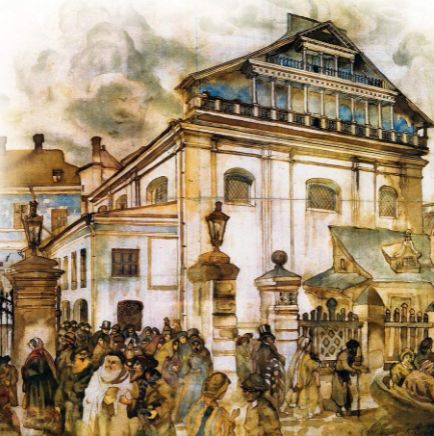
Even without the kahal committees, “Jewish communities
continued to deliver taxes and conscripts, as the state required of them.”5
Over time, however, their internal leadership lost their status and powers.
Rebellious youngsters and intellectuals, as well as entrepreneurs and rich
merchants, challenged the old guard and its traditional system of control. The
community was divided over the key question that keeps recurring: Who speaks
for the Jews, and on what authority?
The tsarist regime’s erratic flip-flopping between wanting
to rule the Jews as a collective and fearing that their cohesion would
constitute a threat reflected its growing apprehension about national
minorities in general. The Poles, Ukrainians, Byelorussians, and Caucasian
peoples all awaited the opportunity to assert their independence. Tsar
Nicholas’s ferocity and frequent, unanticipated policy swings compelled the
Jews to reconsider their future. Increasingly concerned that he would take
devastating steps against them, they came up with innovative initiatives to
ensure the continued existence of their collective life outside (or after) an
imperial Russia.
However, most residents of the Pale of Settlement were
unaffected by the romantic ideas of the Enlightenment in Germany and could
conceive of no solutions beyond their traditional way of life. Hasidic Judaism
remained the dominant force among Russian Jewry until the second half of the
nineteenth century. Under the rule of Alexander II, more and more educated Jews
began trying to fit into the empire along the lines of the western European
model, as fully equal citizens.
The residence rights accorded to these “Makov Circular Jews” always rested on a shaky legal
foundation, and the Ministry of Internal Affairs withdrew the circular in 1893.
Image of a temporary permit to travel for business
outside the Pale of Settlement:
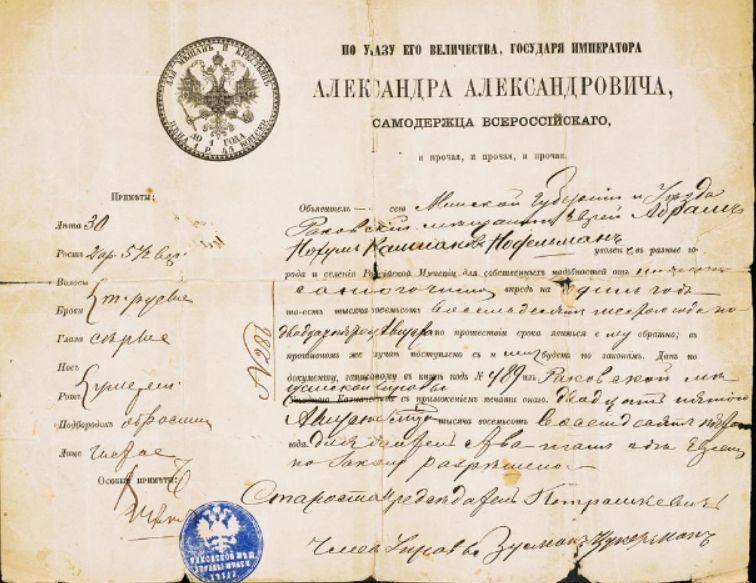
The reforms during his reign, the upheavals in western
Europe, and the revolutions of 1848 laid the foundation for the emergence of
anti-establishment Jewish nationalist movements. They fed upon the socialist
and liberal revolutionary trends in the West while also drawing inspiration
from the Bible and ancient Jewish sovereignty. After Russia’s defeat in the
Crimean War, Alexander II became increasingly dependent on the taxes paid and
services rendered by affluent and educated Jews. They became indispensable to
the rehabilitation of Russia’s infrastructure, and since the regime was so
dependent on private capital, a small cadre of merchants became significant
financial players for the Russian government.
The new Jewish elites also became the principal
mediators between the imperial regime and their own communities. In the 1870s,
wealthy Jews, notably the Günzburg family, were known for their philanthropy
and efforts to sway the government on Jewish affairs. They succeeded in getting
some of the restrictions on settlement abolished, as well as expanding the
Jews’ freedom of occupation outside the Pale. Their role was similar to that of
the court Jews of central Europe after the Thirty Years’ War, and they secured
an elevated legal status for themselves.6 These developments and Tsar
Alexander’s reforms spurred an internal debate about the opportunities and
dangers inherent in Russification versus the preservation of a distinct Jewish
existence. Some of the wealthy and educated Jews in cities such as Odessa and
St. Petersburg were active in reshaping community life with an emphasis on
liberal Jewish-Russian integration.
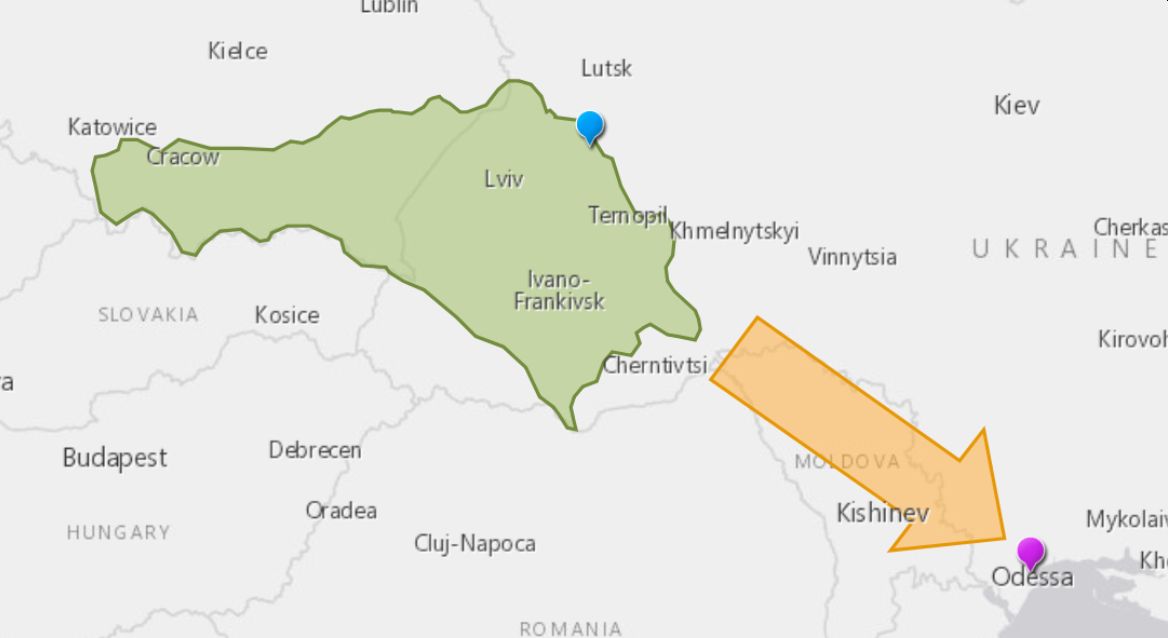
The story of Odessa is a
fascinating example of Jewish flourishing in eastern Europe. In 1790, according
to an unofficial census, there were a few hundred Jews living in the city,
mostly petty traders. By 1860, their ranks had swelled to 17,000, about
one-quarter of the city’s population. By the turn of the century, Odessa was
spoken of as a “Jewish city” and the Jews had become its economic engine, and
in the early twentieth century, two-thirds of the craftsmen and industrialists
in Odessa were Jews. Odessa, in the words of historian Charles King, “was New
Russia’s answer to the shtetl,” a place where Jews were not isolated. Instead,
they fit into society, were nourished by the prevailing enlightenment, and were
optimistic that they could convince the Russian authorities of their value.
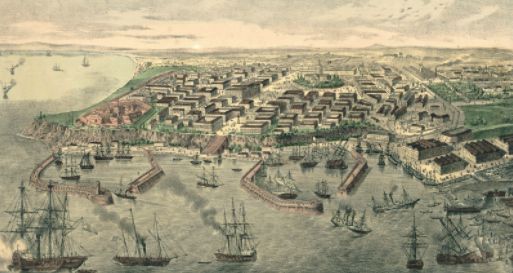
Imperial authorities cooperated with the modernizers
by banning the wearing of the kapotah, the
knee-length jacket donned by Orthodox Jewish men, who were now battling for the
survival of their traditional way of life. They sometimes used underhanded
methods to do this, such as leveling false accusations of subversion against
poet Judah Leib Gordon, one of their harshest critics. They reported him and
his wife to the Russian authorities, who banished them on the pretext of
anti-tsarist subversion.
Hasidic Jews saw Odessa as a den of Jewish thieves and
heretics. In Fishke the Lame (The Book of Beggars), by S. Y. Abramovitsch, the father of Yiddish literature known by his
pen name Mendele Mocher Sforim,
the main character, Fishkeh, sums it up by saying:
“Your Odessa is not for me.”7
Among the Jewish intellectuals in Russia were early
Zionists who preached progress but condemned the Western tendencies toward
assimilation. They produced flourishing Hebrew literature that drew upon
biblical sources and extolled the glory of the Jewish sovereignty of ancient
times. Avraham Mapu (1808–1867) became one of the most important heralds of
modern Hebrew literature, arousing the national consciousness of young Jews
with his 1853 book Love of Zion, the first modern Hebrew novel.
Mapu blazed a path for the celebrated writer Peretz Smolenskin (1842–1885), who called for the revival of
Hebrew nationalism and denounced Jewish integration in Russia as a shameful
surrender on the part of an ancient nation. Smolenskin,
influenced by the Polish national uprising in 1863, condemned both the rabbinic
establishment and the forces of assimilation. Having grown up in a small
village in Byelorussia and having been a fervent rebel against the yeshiva
world he was raised in, Smolenskin was also the
harshest and most prominent critic of Reform Judaism and the Enlightenment
ideas of Moses Mendelssohn, which he was exposed to after moving to Odessa. He
continued his relentless struggle against them from Vienna, where he founded
the Hebrew monthly Hashachar (“The Dawn”), devoted to
the revival of the Hebrew language, in 1869.
In advocating Hebrew nationalism as a substitute for
assimilation, Smolenskin was advancing a similar
ideology to Moses Hess, but his was based on and couched in the Hebrew
language. Like Hess, and unlike other Russian Jewish intellectuals who admired
what modernity and enlightenment had achieved for their brethren in the West, Smolenskin condemned the Reform model for making Judaism an
empty, lifeless, universal religion. He despised it for erasing the yearning
for Zion from the liturgy, for abandoning Hebrew and replacing it with German,
and for giving up the solidarity of the People of Israel and their symbiosis of
nation and religion. He argued that religion and nationalism went hand-in-hand
in Judaism, and the Hebrew language was the essential foundation of both. Those
who renounced the use of Hebrew in their prayers were betraying their people
and their religion; to his mind, without the Hebrew language, there was no
Torah, and without the Torah, there was no Jewish nation.8
On the spectrum between Orthodoxy, which wanted to
remain aloof from the rest of the Russian Empire, and the forces of innovation
and modernity, which sought integration and progress within the empire, there
were also the voices of some educated rabbis who, decades before Pinsker and
Herzl, emphasized that a commitment to Jewish nationhood was no less important
than a commitment to religion, and perhaps even took precedence. They believed
the preservation of the Jews’ tribal nature mandated them to maintain strong
ties to their historical homeland and to Hebrew as an everyday language, not
only as a sacred tongue. These pre-Zionist rabbis spoke in messianic terms of
the “Restoration of Israel.” They were inspired by rabbis from outside the
Russian Empire, most prominently Nachman Krochmal, Zvi Hirsch Kalischer, and Judah Alkalai, all
of whom were early harbingers of Religious Zionism in the Land of Israel. The
ability of Orthodox rabbis to adopt these messianic and revolutionary calls for
settlement in what was then a neglected corner of the Ottoman Empire is a
testament to the latent potential within the Jewish religion to adapt itself to
the world of modernity.
The succession of Alexander III
By 1880, Russian Jews could still not integrate along
with the western European model, but they did enjoy a reasonable level of
personal and public security, like other imperial minorities, both in the Pale
of Settlement and the cities. The tsarist regime did not degenerate into mass
murder, notwithstanding some violent, arbitrary outbursts on the government’s
watch, as well as substantial oppression and discrimination. But the
assassination of Alexander II in 1881 and the succession of Alexander III led
to an abrupt change in the lives of Russia’s Jews.
In response to the chaos caused by a series of such
expulsions in 1880, the Minister of Internal Affairs, Lev Makov,
issued a ministerial circular dated 3–15 April 1880, permitting Jews who had
settled illegally before that date to remain in place. The residence rights
accorded to these “Makov Circular Jews” always rested
on a shaky legal foundation, and the Ministry of Internal Affairs withdrew the
circular in 1893.
A major revision of the Pale occurred in the wake of
anti-Jewish pogroms of 1881–1882 and continued at
differing levels of intensity and capriciousness over the next two decades with
the backing of the regime. The tsars directly encouraged harsh legal measures
and indirectly approved “spontaneous” attacks on Jews. Every day brought fresh
peril, and their fear of this arbitrary violence disrupted their vision of
progress and integration under the Romanov monarchy. Even the flourishing
community of Odessa, about whom the Yiddish phrase “You
can live like a king in Odessa” was coined, was abruptly transformed from
being a place of great hope for tolerant cosmopolitanism into a place of anti-Semitic
chaos. As the Golden Age in Spain, the promise and calamity of Odessa were a
repetition of what could happen to the Jews without Jewish sovereignty.
This insecurity and chaos gave a boost to Zionism and
the forces of liberalism. It also strengthened the spirit of the socialist
revolution, although in the early years of the twentieth century, up to the
October Revolution, Jews “broadly rejected socialism in any guise…as the
solution to the problem of the Jews in Russia.”9 Despite this, many who were
motivated by the winds of secularization and political instability wanted to be
part of the overthrow of the autocracy.10
In the end, however, the irresistible allure of the
American Dream and the drive to migrate westward proved supreme. Between 1881
and 1914, two million Jews left the Russian Empire for the United States,
accounting for some 80 percent of their emigration from eastern Europe. Some
brought revolutionary, left-wing ideas to the US and featured among the leaders
of its socialist and communist movements. Only a handful of Russian Jews went
to Palestine, many of them influenced by the Lovers of Zion (Hibat Zion) movement,
which had become the exemplar and catalyst of organized Zionism in Eastern
Europe.
The American Jewish community was transformed by this
mass migration. With time, the United States would become the most important
Jewish community in the world. However, toward the end of World War I, there
were still more Jews in the teetering and soon-toppled Russian Empire than
anywhere else in the world because of tremendous natural growth rates, despite
the trauma of the pogroms. At the turn of the twentieth century, the number of
Jews in Russia was estimated at between five and seven million.11
The Kishinev pogrom
The constant fear of pogroms and revolutionary ferment
drove many Jews to political activism. Disgusted at the passivity and fatalism
of their parent's generation, young Jews refused to accept further affronts to
their dignity or to wait to be slaughtered. They mobilized to fight the
violence and depredations against their people at all levels of society and the
state. The Jews of imperial Russia reached their breaking point with the
infamous Kishinev pogrom of 1903.
Many Jews realized that eastern Europe had become a
deathtrap. But those who were so versed in commemorating calamities were also
adept at denying reality and snapping back to old routines. A debate emerged:
What should the future hold for the Jews of the Russian Empire? They grappled
with many different ideas, both before and after the overthrow of the Romanovs
in 1917, including Jewish sovereignty and new ways of living in the Diaspora.
At one end, Zionism called for the “negation of the diaspora” and the creation
of a Jewish state. On the other, there were demands for full integration in the
Diaspora based on civil, economic, and political equality. Yet others called
for Jewish autonomy in the Diaspora.
Jews also debated two models of cultural autonomy
after the fall of the tsars; one model envisaged the Jews as a minority like
any other recognized national group in a proletarian Russian state while the
other saw them enjoying self-rule as part of a federative arrangement in a
liberal state in which national groups would have cultural (but
non-territorial) autonomy. The latter was the vision of Simon Dubnow, who declared:
It is our duty to fight against the demand that the
Jews give up their national rights in exchange for rights as citizens…. Such a
theory of national suicide that demands that the Jews make sacrifices for the
sake of equal rights, the like of which are not demanded of any other
nationality or language group, contradicts the very concept of equal rights and
of the equal value of all men.12
One element cropped up in every discussion of the
Jewish future, the definition, status, and location of the Jewish homeland. In
the dispute between advocates of sovereignty and those who favored a
diaspora-based solution, the appearance of the Hibat Zion movement gave a
significant boost to the Zionist idea. However, Zion argued that Jews would
forever be foreigners in Russia, and the way out of their distress was
emigration to their historic homeland. Diasporists
and proponents of autonomy emphasized the concept of “hereness”, which meant
that Jews belonged to the places where they lived, just like any other
nation.

Prominent among the diaspora advocates was the Bund
(Yiddish for “union”), a movement founded in 1897 as a “General Union
of Jewish Workers” in Russia, Poland, and later, Lithuania. It was the
first social-democratic organization in the Russian Empire and became a mass
movement. As such, it was the most modern and popular diasporic model in
eastern Europe and a key component in the formation of the socialist movement
in Russia and the pan-European left.
There were two contradictory streams within the Bund,
one universalist and the other specifically Jewish. The first advocated unity
with all socialist movements, Jewish and non-Jewish, for the sake of the
proletarian class struggle; the second called for joining with other Jewish
movements to preserve and bolster Jewish particularity and national solidarity.
The Bund’s attempt to maintain an independent Jewish entity within the Russian
Social Democratic Labor Party created internal contradictions and provoked
clashes with both Jewish and non-Jewish bodies. In Jewish circles, its
universalism aroused opposition due to the fear of assimilation and erosion of
tradition.13 But among Russian socialists, the majority, including Lenin in his
early role as the socialists’ leader-in-exile, saw the Bund’s goal of becoming
an independent ethnonational party as a threat to the unity of the working
class.
In 1903, Lenin contended that the Jews had long ceased
to be a nation, “for a nation without territory is unthinkable.” He dismissed
the notion of diaspora nations in general and of a Jewish diaspora nation in
particular, claiming: “The idea of a Jewish nationality runs counter to the
interests of the Jewish proletariat, for it fosters among them, directly or
indirectly, a spirit hostile to assimilation, a spirit of the ‘ghetto.’”
Historian Zvi Gitelman writes that “for Lenin, there was no Jewish nation, only
a ‘Jewish Problem’,” and this problem would only be solved if the Jews
assimilated and abandoned their distinct cultural identity.14
The Bund never succeeded in finding the right formula
to ensure the survival of the Jewish tribe in alliance with other socialists.
At the same time, Jewish thinkers proposed two other agendas that were not as
politically influential as the Bund’s but still had an impact. The more
important of these was Jewish autonomism, Simon Dubnow’s
vision of Jewish autonomy as a diaspora nation. The other was Yiddishism,
socialist intellectual Chaim Zhitlovsky’s idea for a
“Yiddish language community” to replace the Jews’ religion-based identity,
which he thought was going to disappear. Zhitlovsky’s
form of autonomy would first be established in the multicultural Russia that
would emerge from the embers of the revolution. He suggested that Yiddish would
be the language of instruction in schools and the working language of other
institutions. Yiddishists held a conference in
Bukovina in 1908 and declared Yiddish “a national language of the Jewish
people.”15
Zhitlovsky was something of a Zionist before taking a sharp turn
and backing the Bolsheviks. Realizing his mistake, he later fled to the United
States and promoted the idea of turning the Land of Israel into a Yiddish, not
Hebrew, national cultural center. He predicted that masses of Jews would stream
to a Yiddish-speaking national home. Historian Zvi Gitelman sardonically said:
“Whether Zhitlovsky seriously thought that Sephardic
Jews would adopt Yiddish, or whether he simply ignored their existence, is not
clear, but telling.”16 Zhitlovsky died in Canada,
together with his eccentric proposal.
Simon Dubnow showed some
sympathy for Yiddishism but did not see it as the heart of the national culture
of eastern European Jewry. For him, the Jews were multilingual people and
speakers of Russian, Yiddish, and Hebrew. Dubnow, a
gifted historian, considered himself a missionary for Jewish history. He made a
great contribution to the study of eastern European Jewry and called upon them
to proudly brandish their past as the key to ensuring their national future. He
advocated the study of history and the documentation of Jewish life as a modern
alternative to Torah study. He also earned the widespread recognition of social
scientists as the leading expert in the field of diaspora studies, a branch of
the study of nationhood.
Dubnow
was a member of the intellectual elite and emerged in the Byelorussian part of
the Pale of Settlement; he later moved to St. Petersburg, Odessa, Kaunas,
Berlin, and Riga. The Kishinev pogrom of 1903 shocked him deeply and led him to
cooperate with Ahad Ha’am and Hayim Nahman Bialik in investigating the
massacre. “Stunned by the thunder of Kishinev,” he later wrote, “we each sat in
our own homes in Odessa with broken hearts and seething with impotent anger.
When the horrendous news reached our town, so close to the martyrs, the pen
dropped from my hand and I could not return to my historical work for many
days.”17
Dubnow, Ahad Ha’am,
Bialik, and fellow intellectuals Yehoshua Rawnitzki
and Mordechai Ben Ami, who were all neighbors in Odessa, published an anonymous
manifesto in Hebrew, penned by Ahad Ha’am, which became a clarion call for
Jewish self-defense:
Brothers.… It is a disgrace for five and a half
million souls to place themselves in others’ hands, to stretch out their necks
and cry out for help, without trying to defend themselves, their property, and
the dignity of their lives. And who knows if it was not this disgrace of ours
that did not cause the start of our degradation in the eyes of all the people
and to turn us into the dirt in their eyes?… It is only he who knows how to
defend himself who is respected by others. If the citizens of this land had
seen that there is a limit, that we too, although we will not be able nor
willing to compete with them in robbery, violence, and cruelty, are nonetheless
ready and able to protect what is precious and sacred to us, until our last
drop of blood. If they had actually seen it, there is no doubt, they would not
have fallen upon us with such nonchalance; because then a few hundred drunkards
would not have dared to come with clubs and pickaxes in their hands to a large
community of Jews of some forty thousand souls to kill and to violently rob to
their hearts’ content. Brothers! The blood of our brethren in Kishinev cries
out to us: Shake off the dust and be men! Stop whining and begging, stop
reaching out to those who hate you and ostracize you, that they should come and
save you. Let your own hand defend yourself!18
Even after the Kishinev pogrom, Dubnow
retained his faith that the Jews could achieve a life of dignity and meaning as
a nation within the framework of social and cultural autonomy in the Diaspora,
in nation-states where they were a minority. He considered the Jews the
prototype for diaspora nations and formulated his own radical doctrine for
Jewish nationhood, writing:
When a people lose not only its political independence
but also its land when the storm of history uproots it and removes it far from
its natural homeland and it becomes dispersed and scattered in alien lands, and
in addition loses its unifying language; if, despite the fact that the external
national bonds have been destroyed, such a nation maintains itself for many
years, creates an independent existence, reveals a stubborn determination to
carry on its autonomous development, such a people has reached the highest
stage of cultural-historical individuality and may be said to be
indestructible, if only it cling forcefully to its national will.19
Thus the idea that the Jewish people’s mobility
strengthens and deepens its culture, and that non-territorial nationhood is the
pinnacle of moral achievement because it is unencumbered by borders and the
monopoly over the use of force has become a pet thesis for liberals and
internationalists.
Letter in the handwriting of David Wolfson - on a
postcard with Lillien's work:
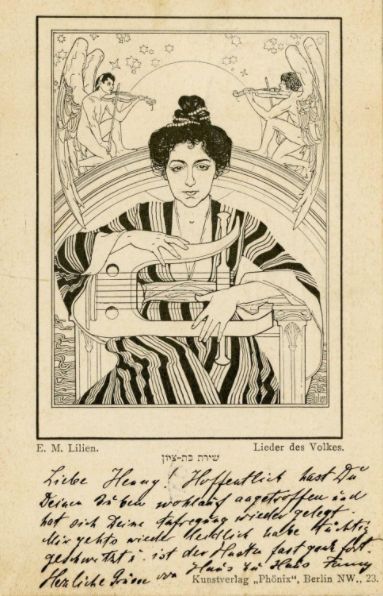
While the Hibat Zion movement was sending pioneers to
the Land of Israel, Dubnow opposed the Zionist
program of securing territorial sovereignty, deeming it impractical. Amid the
pogroms sparked by the assassination of Tsar Alexander II in 1881, he argued
that isolating the Jews in the backwater of Ottoman Palestine would degrade them
culturally and ethically, and they would “sink into Asiatic culture.” He wrote
to Moshe Leib Lilienblum, who had decided to join the
Lovers of Zion, that sovereignty was a “straw to clutch at, and those who grasp
at it will surely drown…in ignorance and barbarism.”20 He also disagreed with
his friend Ahad Ha’am’s idea that the Jews could establish a center of modern
life in Palestine. Dubnow maintained that from a
moral perspective, a diaspora national existence was preferable to an
exclusivist, territorial-sovereign nationhood, which would inevitably cling to
chauvinistic tribal nativism and state violence.
Dubnow’s adherence to the idea of diasporic autonomism was
rooted in his faith that Russia would one day become a liberal, multinational
state. This remained his opinion up until the Russian democrats surrendered to
the Bolsheviks during the 1917 Revolution.
In 1922, he took refuge in Berlin. Despite the failure
of the Jews to integrate into Soviet Russia and the early success of Zionism in
Palestine and the Balfour Declaration, Dubnow
continued to believe that the national future of the Jews lay in Europe. He
rejected assimilation as unnatural both psychologically and morally, and as a
threat to the Jewish people. Only a vibrant diaspora nation, united and
organized, without territorial sovereignty, could serve as the inspiration for
a progressive, pluralist, and multicultural society. Dubnow’s
vision was to build on the Jews’ proven success in keeping their ethnic
particularity, via their language, culture, and education, and their ability to
maintain national institutions. He wanted to revive the kahal system, but not
based on religious principles or hierarchy as it had been in the Middle Ages
and in the Russian Empire. The kahal he wanted to recreate would be of a
democratic-republican nature with a clearly secular national orientation. The
Jewish diaspora nation would serve as the model for multiethnic life in modern
states whose populations were not ethnically homogeneous and did not demand
assimilation into the predominant group.21
Even after the pogroms of 1903 and other upheavals, Dubnow believed Russia would become a multiethnic, liberal,
democratic country in which the Jews could flourish with
national/non-territorial autonomy. After the 1905 Revolution, when elections
for parliaments (Dumas) were first allowed, he played a key role in the
formation of the League for the Attainment of Full Rights for the Jewish People
of Russia. The goal of the league was “the realization in the full measure of
civil, political, and national rights for the Jewish people.” It organized as a
pressure group, not as a party, and mobilized Jewish voters to ensure “the
elections of candidates, preferably Jewish, who would strive for full rights
for the Jews and a democratic regime of Russia.”22
Indeed, many Russian Jews voted in the 1906 elections
for the liberal party, the Kadet, because of its
commitment to constitutional order and universal suffrage. Thousands of Jews
“who had previously no contact with political life were now drawn into it by
the exercise of their franchise. Russian Jews could feel as they had never felt
before that they had a stake in the future of Russia.”23
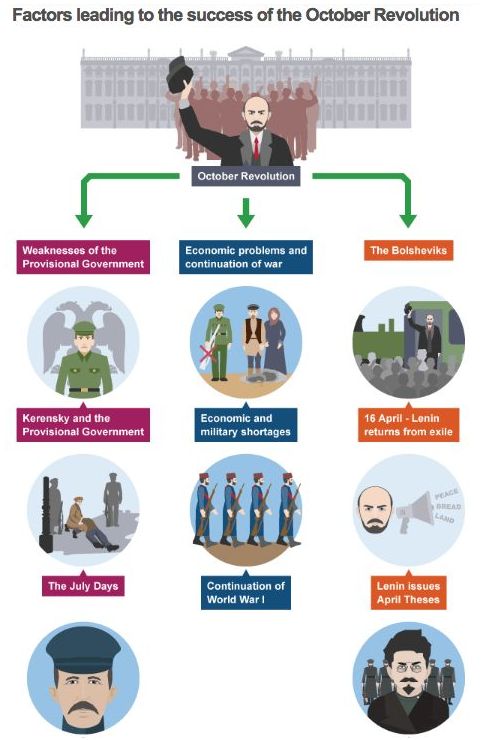
By the time the Bolsheviks seized power, almost all
Russian Jews, who were officially emancipated in the democratic 1917 February
Revolution, were anti-Bolsheviks. But when the Russian Civil War broke out and
anti-Bolshevik forces of the White Army committed anti-Jewish atrocities, many
Jews adopted the Bolsheviks as allies.24
As he saw fascism rising in Europe and the Jewish
national home in Palestine becoming a reality, Dubnow
still clung to his faith that the diaspora nation would be the dominant mode of
Jewish life, even if a Jewish state were to be established. He did not agree
that people must constantly strive for sovereignty to be a nation. Dubnow was murdered by a Latvian collaborator during the
Nazi occupation of Riga in 1941. For many, his cruel death became the symbol of
the disaster inherent in the naïve faith of living a secure Jewish life as a
scattered diaspora nation.
I created the Jewish State
Only after the appearance of Theodor Herzl on the
world stage did Palestine become a central focus of Jewish national sentiment.
He laid the ideological and organizational foundations for the Zionist
movement. His pamphlet Der Judenstaat (The Jewish
State, 1896) called for the massive evacuation of Jews from Europe and the
restoration of a Jewish state in the Holy Land. The Jewish State was a
prophetic document, preaching the ingathering of exiles as the solution to the
Jewish Question in Europe, and granting the Jews equal status among the
nations.25
Herzl provided concrete answers on how to transplant
Jews from Europe to Palestine, and how to build political and financial
institutions, schools, and settlements. A charismatic and relentless figure, he
traveled the capitals of Europe and beyond, building international backing of
imperial powers and alliances with other actors on the world stage. In many
ways, Herzl is the first modern Jewish statesman, who paved the way for
diplomacy in Israel both before and after statehood, and also for Diaspora Jewry.
In August 1897 Herzl presided over the First Zionist Congress in Basel,
Switzerland. After three days of remarkable deliberations, with hundreds of
enthusiastic Jewish delegates from seventeen countries in attendance, as well
as many non-Jews and European journalists, Herzl confided to his diary: “If I
were to sum up the Basel Congress in a single phrase, which I would not dare to
make public, I would say: in
Basel I created the Jewish State.”
1. S. Zeitilin, “The Council
of Four Lands,” The Jewish Quarterly Review 39, no. 2 (1948), 212.
2. Benjamin Pinkus, The Jews of the Soviet Union:
The History of a National Minority (Cambridge Russian, Soviet and Post-Soviet
Studies, Series Number 62),1988, 12.
3. Salo Wittmayer Baron, The Russian Jew under
tsars and Soviets, 1976, 112.
4. Pinkus, Jews of the Soviet Union, 16.
5. Benjamin Nathans, Beyond the Pale: The Jewish
Encounter with Late Imperial Russia (Studies on the History of Society and
Culture Book 45) Part of: Studies on the History of Society and Culture (17
Books), 2002, 34.
6. Ibid.
7. Charles King, Odessa: Genius and Death in a City of
Dreams (New York: W. W. Norton & Co., 2011), 97–106.
8. Louis Greenberg, The Jews in Russia: The
Struggle for Emancipation (Vol 1 & 2), 1987, 141.
9. Michael Stanislawski, “Why
Did Russian Jews Support the Bolshevik Revolution?” Tablet, October 25,
2017.
10. Jonathan Frankel, “The Jewish Socialism and the
Bund in Russia,” in The History of the Jews of Russia: 1772–1917, 255
11. Anna Geifman has noted
that in 1903 there were 136 million people in the empire, including seven
million Jews. See Anna Geifman, Thou Shalt Kill,
Revolutionary Terrorism in Russia, 1894–1917 (Princeton: Princeton University
Press, 1995), 32.
12. Simon Rabinovitch, “The
Dawn of a New Diaspora: Simon Dubnov’s Autonomism, from St. Petersburg to
Berlin,” Leo Baeck Institute Year Book 50, no. 1 (January 2005), 270.
13. Charles E. Woodhouse and Henry J. Tobias,
“Primordial Ties and Political Process in Pre-Revolutionary Russia: The Case of
the Jewish Bund,” Comparative Studies in Society and History 8, no. 3 (April
1966), 331–360.
14. Zvi Gitelman, “The Jews: A Diaspora within a
Diaspora,” in Nations Abroad: Diaspora Politics and International Relations in
the Former Soviet Union, eds. Charles King and Neil Melvin (Boulder, Colorado:
Westview Press, 1998), 61.
15. Joshua M. Karlip, The
Tragedy of a Generation: The Rise and Fall of Jewish Nationalism in Eastern
Europe (Cambridge, MA: Harvard University Press, 2013), 10.
16. Gitelman, “The Jews: A Diaspora within a
Diaspora,” 61.
17. Simon Dubnow, “Ahad
Ha’am’s Scroll of Mysteries (25 Years Since the Kishinev Massacre),” Hatekufah 24 (1934), 416
18. Ibid., 416–420
19. Rabinovitch, The Dawn of a New Diaspora:
Simon Dubnov's Autonomism, from St. Petersburg to Berlin August 2005 The Leo
Baeck Institute Yearbook 50(1):267-288281.
20. Miriam Frenkel, “The Medieval History of the Jews
in Islamic Lands: Landmarks and Prospects,” Peamim 92
(2002), 32.
21. After Dubnow wrote the
“Diaspora” entry in the Encyclopedia of Social Sciences in the 1930s, the term
“diaspora” became almost exclusively linked to the history of and political
sociology of the Jews.
22. Sidney Harcave, “Jews
and the First Russian National Election,” The American Slavic and European
Review 9, no. 1 (February 1950), 33–41.
23. Ibid., 41.
24. Michael Stanislawski, “Why Did Russian Jews
Support the Russian Revolution?,” Tablet, October 25, 2017.
25. Aharon Klieman, “Returning to the World Stage:
Herzl’s Zionist Statecraft,” Israel Journal of Foreign affairs 4, no. 2
(2010),76.
For updates click homepage here